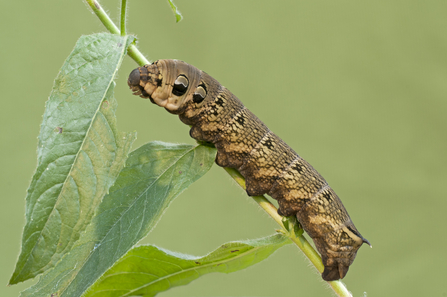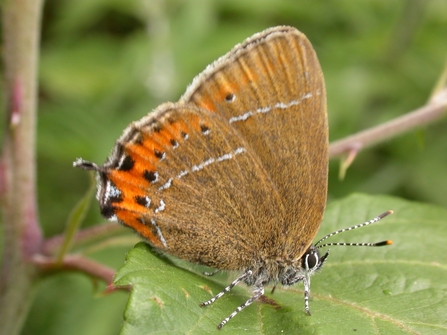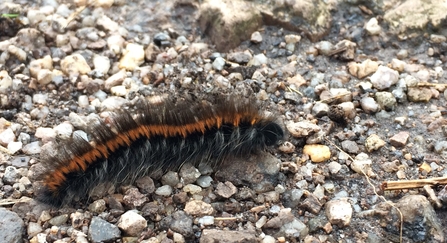But some species become easier to spot as they reach their full size and wander in search of a place to pupate. Every August and September, The Wildlife Trusts are inundated with messages about elephant hawk-moth caterpillars, with people excitedly sharing their sightings or asking for help with identification. These chunky trunk-like caterpillars are searching for a sheltered spot on the ground, where they’ll burrow into the soil or leaf litter and pupate, spending the winter within their cocoon. They won’t emerge as adults until around the following May.
Discover the different ways that moths and butterflies spend the winter

Elephant hawk-moth caterpillar ©Dawn Monrose
Many moths and butterflies spend the winter like this, tucked away in their pupal form, waiting to emerge in warmer weather, but some species spend the winter as eggs, including the rare black hairstreak. This beautiful butterfly is on the wing for a few short weeks around June, when females will lay eggs on blackthorn twigs. The larvae within will fully develop before winter arrives but won’t emerge from their eggs until spring.

(C) Philip Precey
However, the most common way for moths and butterflies to spend the winter is as a caterpillar. They’ve adopted all sorts of survival strategies, with some species even continuing to feed throughout milder spells, though most enter a dormant state known as diapause (a little like hibernation in mammals) and don’t feed again until spring. Some caterpillars enter diapause as soon as they hatch from their egg, others feed for a while and enter diapause when they’re partly, or even fully grown.
One species that spends the winter as a fully fed caterpillar is the fox moth. In early summer, young fox moth larvae are black with orange bands, but by September they’ve grown into huge hairy orange caterpillars. In late summer and early autumn they can often be seen on paths or low vegetation, before they secret themselves away in loose soil or leaf litter for the winter. In early spring, they’ll emerge ready to pupate, and are often seen basking in the sunshine.

(C) Tom Hibbert
A few species buck the trend and overwinter as adults, sheltering from the worst of the weather in caves, tree cavities or even sheds and garages. These include the small tortoiseshell and peacock butterflies that occasionally try to hide away in houses, and the herald moths which huddle in groups on the walls of caves. A small number of hardy moths are actually active in the winter months, such as the winter moth and December moth – look out for them flying around outdoor lights on winter evenings.
